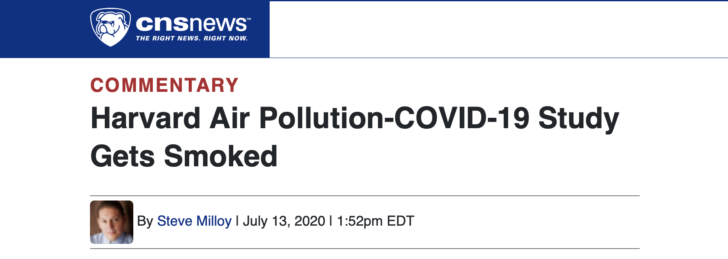My column at CNSNews.com. (Web | PDF)

A new study has completely debunked recent hyped and unfounded claims from Harvard University researchers that air pollution increases the risk of death from COVID-19 and that the Trump EPA was making the pandemic worse by not further tightening national air pollution standards.
The saga revolves around microscopic soot and dust particles in the air called particulate matter (PM) 2.5. The Clinton EPA invented PM2.5 as a toxic air pollutant in need of regulation in 1997. Relying on a couple of controversial studies from a cadre of Harvard University researchers, the EPA claimed that PM2.5 caused 15,000 premature deaths per year.
Although EPA’s committee of outside scientific advisors concluded at the time that there was no evidence connecting PM2.5 to death, the Clinton EPA regulated anyway. This regulatory action forced the PM2.5 air standards to be reviewed for tightening every five years.
During the 2012 PM2.5 review cycle, the Obama EPA tightened the PM2.5 standard by about 20 percent based on absurd claims that PM2.5 was responsible for about 570,000 deaths (about 1 in 5 deaths) in the US every year.
Last December, amid a new PM2.5 review cycle, the EPA’s committee of outside science advisers again concluded that EPA failed to provide evidence that PM2.5 killed anyone or that there was any benefit to tightening the standards more. This time and over the vociferous objections of environmental activists, including the Harvard “researchers,” the EPA is heeding the committee’s advice and is leaving the standards where they are.
Then COVID-19 hit.
Attempting to surf the virus crisis and undaunted by the dismissive review of their work by EPA’s outside science advisory committee, members of the Harvard cadre published in early April a study claiming that the most infinitesimal increase in PM2.5 in outdoor air increased the risk of death from COVID-19 by 15 percent.
The New York Times headline about the study read, “New Research Links Air Pollution to Higher Coronavirus Death Rates.” The Washington Post followed up with the linkage to the Trump EPA decision, “Trump officials reject stricter air quality standards, despite link between air pollution, coronavirus risks.” The Harvard study’s claims are now routinely parroted by the media and also play a key role in a recent House hearing on environmental justice.
Now reality has struck back.
A study by University of Washington and Stanford researchers was recently released, reporting that nations with the highest smoking rates had the lowest COVID-19 death rates.
What does smoking have to do with PM2.5? The smoke inhaled from a cigarette, cigar, pipe, marijuana joint or water pipe is virtually all PM2.5, except a lot more concentrated.
While breathing average quality outdoor air in the U.S., you will unavoidably inhale about 10 millionths of a gram of PM2.5 per hour.
The Harvard study claimed that if you had COVID-19 and inhaled a mere 1 millionth of a gram of PM2.5 more per hour (i.e., a total of 11 millionths of a gram of PM2.5 per hour), your risk of death from COVID-19 would increase by 15 percent. If you inhaled 2 micrograms of PM2.5 per hour, you risk of COVID-19 death would increase by 30 percent, and so on.
But in smoking a single cigarette, a person inhales anywhere from 10,000 to 40,000 micrograms of PM2.5 in 5 to 10 minutes. According to the Harvard researchers, then, smokers should be dying in droves from COVID-19.
The new study reports the exact opposite. Countries with the highest smoking rates have the lowest COVID-19 death rates. What’s the explanation?
The University of Washington and Stanford researchers wouldn’t go so far as to say that smoking has some sort of protective effect against COVID-19, but one thing is clear: intense PM2.5 exposures from smoking doesn’t worsen COVID-19 health outcomes. And this is not surprising.
Despite the demonstrable and nondebatable reality that PM2.5 doesn’t cause premature death, the Harvard study was based on an epidemiologic model that assumes PM2.5 causes death. Contrast that fake modeling approach with the University of Washington/Stanford study that relied on actual data for smoking and COVID-19 death rates.
None of this should be taken as a recommendation for smoking. Overuse of tobacco is unhealthy. Yet the facts are what they are. Increased PM2.5 doesn’t increase the risk of COVID-19 death. The Harvard study is junk science. And the Trump EPA is not worsening the pandemic by maintaining air quality standards issued by the Obama EPA.
Steve Milloy publishes JunkScience.com, served on the Trump EPA transition team and is the author of “Scare Pollution: Why and How to Fix the EPA” (Bench Press, 2016).
